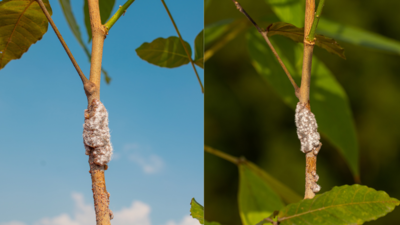ARTICLE AD BOX

Scientists at IISc found that the red lac pigment, earlier thought to come from insects, may actually be made by a fungus living inside them
BENGALURU: The red
lac pigment
, long thought to be made by insects, may actually originate from a
yeast-like fungus
living symbiotically inside them, researchers at IISc have found. By sequencing the lac insect’s microbial community, the team from the Department of Developmental Biology and Genetics discovered that only the fungus — not the insect or its bacteria — carried genes needed to produce
laccaic acid
, the key compound in the pigment. Their findings were published in the Proceedings of the National Academy of Sciences. “For thousands of years, India has been a key producer of lac pigment,” Shantanu Shukla, Assistant Professor and corresponding author of the study, said. The pigment, derived from resin secreted by the insect, is widely used in textiles, food colouring, handicrafts, and traditional art.Lac insects
, which feed on the sugary sap of host trees such as “Butea monosperma” (commonly known as Flame of the Forest), secrete shellac and laccaic acid. However, the pathway through which the pigment is synthesised has remained unclear for decades. Repeated efforts to locate the required genes in the insect’s own genome had been unsuccessful.
The new study suggests that the insect lacks the capability to produce tyrosine — an amino acid essential for laccaic acid synthesis — and relies instead on microbial partners. “Such missing nutrients are often supplied by symbiotic bacteria or fungi in insects,” said Shukla.By sequencing the bacterial and fungal communities associated with the insect, researchers narrowed down their search to two candidates: a “Wolbachia” bacterium and a yeast-like fungus. The fungus, previously hinted at but not fully characterised in earlier studies, turned out to possess the entire genetic toolkit for pigment synthesis. This included genes for enzymes that catalyse the formation of aromatic molecules, which form the structural basis of laccaic acid.According to Vaishally, a PhD student and first author of the paper, isolating the role of the fungus was not straightforward. “The fungus is uncultivable, and the insects cannot survive outside their host plants. All our work had to be done using plant-reared insects, which made it challenging,” she said. One striking feature of the fungus is its location and mode of inheritance. It is present not just in the insect’s haemolymph — comparable to blood — but also inside its egg cells. “The fungus enters the oocyte as it matures and is passed on to the next generation. This kind of vertical transmission is rare and noteworthy,” Shukla said.Researchers also observed that treating the insects with a fungicide led to reduced pigment production and stunted growth. This indicates that the insect likely depends on the fungus for more than just pigment synthesis — possibly for other nutrients it cannot obtain from its sap-based diet.“The yeast-like organism is central to the story. Fungal symbionts are still poorly understood in insects, and this study adds to our understanding of their evolutionary role,” Shukla said.The findings suggest a more complex biological relationship behind the production of lac pigment than previously known, and may open up avenues for studying fungal symbiosis in other pigment-producing insects.



.png)
.png)
.png)
















 3 hours ago
3
3 hours ago
3









 English (US) ·
English (US) ·